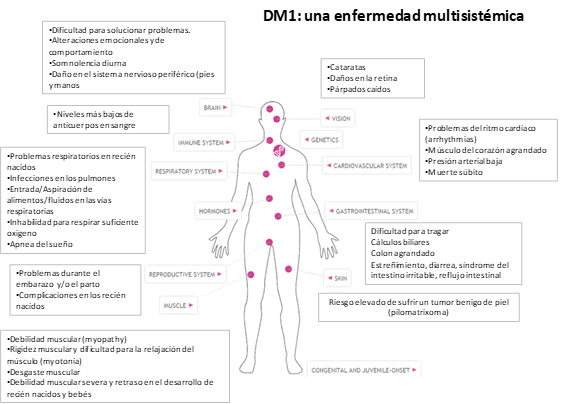Steinert myotonic dystrophy
What is Myotonic Dystrophy
Myotonic dystrophy (DM) is a form of muscular dystrophy that affects muscles and many other organs of the body. DM is a rare muscle disease that affects only 1 in 8,000 individuals and is divided into two main types depending on the genetic alteration that causes the disease.
What is a rare disease? A rare disease is one that affects a small absolute number of people or a small proportion of the population. In Europe, a disease that affects fewer than 1 in 2,000 people is considered "rare." In the United States, a disorder or disease that affects fewer than 200,000 people is defined as such.
Steinert's myotonic dystrophy or type 1 myotonic dystrophy
Type 1 myotonic dystrophy (DM1 or Steinert's disease, OMIM: 160900) is the most common. DM1 is a disorder of autosomal dominant pattern caused by an unstable trinucleotide expansion of cytosine-thymine-guanine [CTG] n located in the untranslated region 39 of chromosome 19q13.3. Excellent reviews on the genetic origin of type 1 myotonic dystrophy DM1 and the role of toxic RNA in pathogenesis are published in the literature.
The [CTG] n expansion responsible for DM1 can vary from 50 to over 1000 repeats and contributes to a wide range of different phenotypes. According to the International Myotonic Dystrophy Consortium (IDMC) (Neurology, 2000), three different clinical phenotypes are recognized in Steinert's dystrophy DM1 according to the age of onset along with [CTG] n repetitions:
-Mild: 50 - 150 CTG repeats
-Classic (adult) and late-onset forms: 100 - 1000 CTG repeats
-Congenital: > 1000 CTG repeats
What symptoms does Steinert's disease have
Clinically, type 1 myotonic dystrophy (DM1) is characterized by progressive muscle atrophy and weakness, cardiomyopathy, insulin resistance, and cataracts, among others. Myotonic dystrophy DM1 or Steinert's disease affects women and men equally.
Significant advances in Steinert's disease R&D at Myogem
Currently, there is no cure for patients with Steinert's disease DM1, only palliative treatments for symptoms, so there are multiple unmet medical needs in this group of patients.
According to data obtained by Myogem Health Company from in vitro and in vivo experiments carried out during the last ten years, the product MYODM has demonstrated its ability to increase the expression levels of MBNL, both MBNL1 and MBNL2, and its effective quantity in the nucleus of human DM1 myoblasts.
The main ingredients of MYODM are the methylxanthines theobromine and caffeine, and no other food contains the proportion of the formulation in MYODM. Methylxanthines are secondary metabolites of plants derived from purine nucleosides and are present in almost 100 different species of plants (including Theobroma cacao, Coffea arabica, and Camellia sinensis).
MYODM contains 20mg of caffeine per capsule, so taking three evenly spaced capsules daily results in a maximum intake of 60mg. In this regard, MYODM complies with current legislation regarding caffeine content in dietary supplements, for which a maximum daily amount of 80mg is accepted.
Taking a 70kg individual as a reference, taking one capsule of MYODM (with its 20mg of caffeine) would be equivalent to an intake of 0.28mg/kg in a 70kg individual. The European Food Safety Agency (EFSA), in its expert reports ("Scientific Opinion on the safety of caffeine," EFSA Journal 2015;13(5):4102), indicates that, in the general healthy population, individual doses of caffeine of up to 3 mg/kg are safe for a 70 kg adult (equivalent to 200 mg of caffeine in a single intake). In general, caffeine doses up to 400 mg/day are considered safe in adults.
Is Steinert's myotonic dystrophy hereditary?
Myotonic dystrophy is a hereditary disease. It is passed from parents to children through an autosomal dominant pattern, which means that if one of the parents has the disease, there is a 50% chance that their children will inherit it, as documented in 'Epidemiological study of congenital Steinert's myotonic dystrophy: Dysmorphic characteristics'.
In the specific case of Steinert's myotonic dystrophy, it is inherited in an autosomal dominant manner through the mother. This means that if the mother has the disease, there is a high probability that her children will also have it.

*Figure adapted from the Myotonic Dystrophy Foundation
